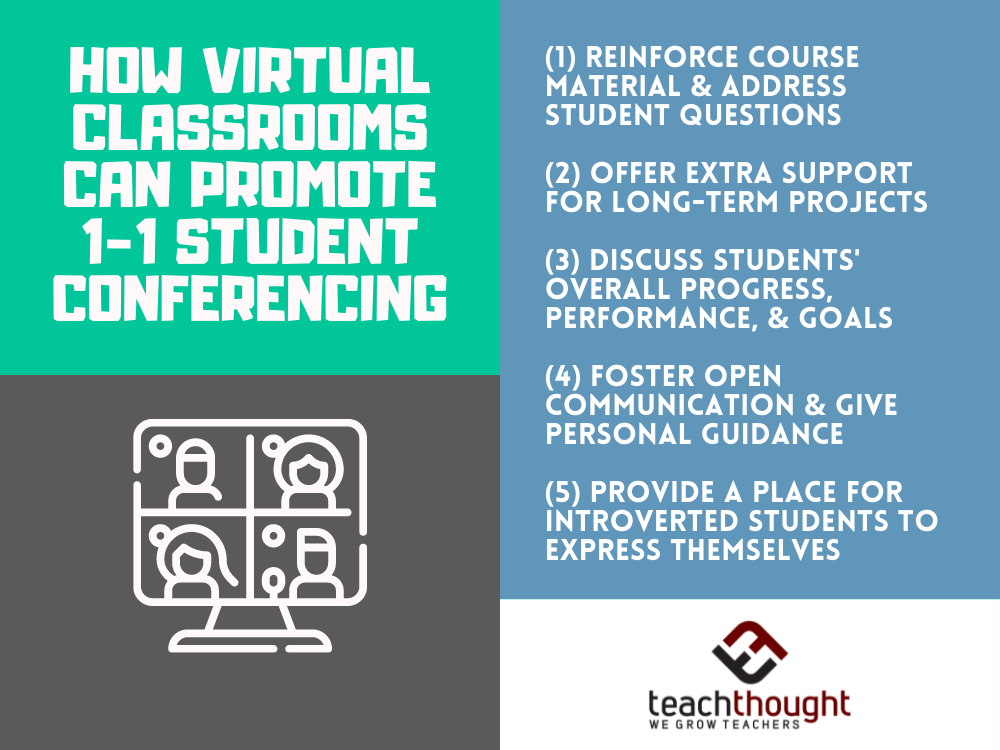
How Can Virtual Classrooms Promote 1-1 Student Conferencing?
contributed by Rosa Fattahi, WizIQ
Why are office hours and student conferences important?
Communication is the cornerstone of teaching and learning, whether it is the teacher’s presentation of material to the students, the students’ expression of knowledge in assignments, or the ongoing verbal dialogue between teachers and students in classroom discussions.
For high school teachers and college instructors in particular, maintaining open communication with students can be one of the most important factors in determining students’ success. Good teachers not only communicate information to their students, but they also work to communicate with and listen to their students in order to help them achieve their best.
However, student-teacher communication during classroom instructional time, in either the traditional or online setting, is not enough. Students often have questions that cannot be addressed during class; long-term assignments like papers and projects require more individualized attention; and student performance must be addressed one-on-one.
Thus, office hours and student conferences are crucial elements in any successful pedagogy, as they provide a forum for offering personalized curricular assistance, strengthening student confidence, and addressing student progress, all of which work to ensure students’ success. While some may see virtual classrooms as a hindrance to conducting meaningful student conferences, we see greater opportunity to connect with students — particularly those who may be more hesitant to open up in a traditional learning environment.
How can teachers use office hours and conferences to support students in virtual classrooms?
Specifically, teachers can use office hours and student conferences to:
1. Reinforce course material and address student questions
During instructional time, it is impossible for a teacher to address all of the students’ individual questions and concerns. Hence, providing students with an established time for office hours, when they can come to receive guidance and additional instruction for curricular matters, is crucial, especially for high school teachers and college student instructors.
2. Offer extra support for long-term papers and projects
Paper, projects, research, and other long-term assignments involve many parts of the learning process, from observation to analysis and synthesis, and so they require additional availability from the teacher. During the time span of such enduring assignments, teachers should hold extended office hours, providing students with more opportunities to have questions answered and receive guidance. Also, when feasible, holding 1-2 conferences with each student per project or other long-term assignment, in which the teacher can assess the student’s progress and offer direction, can be very useful in keeping students on track and guiding them through the process.
3. Discuss students’ overall progress, performance, and goals
It is important to discuss each student’s individual progress, performance, and goals with them periodically during the semester or year, and not all students are eager or outspoken enough to approach the teacher themselves during office hours. Thus, in order to address these matters, high school teachers and college instructors should hold scheduled, one-on-one student conferences during the span of the course.
For example, a short conference with each student at the start of the semester or year is a good way to assess their individual goals and expectations, while also enabling the teacher to get to know each student a little better. Halfway through the course, if the teacher has not otherwise communicated individually with the student during office hours or other interactions, it is a good idea to schedule another one-on-one session; here, teachers can touch base with students to discuss their progress and performance to date, as well as develop a strategy for ensuring the student’s success.
Then, at the end of the semester, a kind of “exit interview” can be useful, helping teachers refine their methods by assessing student experiences while also giving students an opportunity to reflect on the course. In all, the number of scheduled, one-on-one student conferences that a teacher should hold during a course will depend on the length of the course and the needs of each individual student, as some students will require more supervision than others to keep them focused and motivated.
4. Foster more open communication with students and give personal guidance
When given one-on-one time with the teacher, away from the distractions and pressures of other students, students will usually open up and communicate more freely. For a student that may be acting out or not participating in class, or if there is a student causing the teacher concern, for example, a one-on-one conference is the ideal arena for addressing the issue. In addition, some students may seek the teacher’s guidance on personal issues affecting their performance, and office hours are a safe place for students to discuss any difficult matters.
5. Provide a place for quieter, introverted students to express themselves
For quieter and more introverted students, it is especially important to provide them a place where they feel comfortable asking questions and discussing course material with the teacher. Some students are timid and unwilling speak up at all during class, rarely asking questions or volunteering responses. Many of these students just need a bit of gentle nudging from the teacher, and they can benefit greatly from the additional attention and engagement within the private setting of office hours and student conferences. Here, the teacher can work to cultivate communication and, perhaps, even get them to open up.
Both traditional and online high school teachers should hold regularly scheduled office hours for walk-in students to attend for help or guidance, as well as engaging in planned, periodic conferences to address student progress and performance. Still, some teachers may find it necessary to encourage certain students to attend office hours. Offering students some sort of incentive or extra credit is one way to persuade disinclined students to come to office hours, and requiring students to schedule and attend at least 2 one-on-one conferences a semester is a good idea.
Overall, high school teachers and college instructors, in particular, should take advantage of the incredible benefits and potential results offered by the private setting and more interpersonal communication of office hours and student conferences. The bottom line is that teachers should be available to assist and guide students, and holding regular office hours and scheduled conferences are essential parts of making oneself accessible to students.
Using Virtual Classrooms To Host Student Conferences
Due to their many potential uses and benefits, it is evident that there is much to be gained from the one-on-one communication offered by the private arena of office hours and student conferences. However, when working online, holding office hours and scheduled conferences can be rather difficult without the right tools. So, how can online teachers take advantage of the benefits of office hours and student conferences when they are working with students at a distance?
Consider embedding a brief Google Forms survey in a prominent location of your class page — students can complete this ‘pre-conference’ form prior to meeting with you so that you can maximize your time discussing questions, concerns, and triumphs that are important to the individual student, or critical for their growth. Alternatively, some teachers may choose to issue a brief survey at the end of each week with questions meant to gauge student progress; based on the responses (which can be exported to a spreadsheet), the teacher can then determine how students should be prioritized and how to differentiate feedback based on common themes in the responses. Additionally, teachers can give students the opportunity to sign up for these conferences at designated time slots — this helps assure students that they won’t waste time waiting for a conference that might not happen within a class period, and helps you keep track of who you are meeting with and how often.
Another option with office hours is to treat it as a study hall, which you can ask a small group of students to join. Perhaps these students share the same challenges or questions, so you might use the beginning of the office hour session to address them as a group and set up guided practice, then meet one-on-one with students in breakout rooms while the others continue to work independently. Consider experimenting with the ‘5-minute rule,’ where students attempt a challenging task on their own before asking for help from the teacher. This strategy helps set up an expectation that you believe your students are capable of solving complex challenges on their own, but that you are there for guidance and targeted feedback.
It may also be a useful idea to issue a ‘post-conference’ form, which can benefit teachers and students. For students, it gives them an opportunity to reflect on their challenges, new insights, and how they applied feedback, so that they might remember to use those strategies in the future with similar tasks. For teachers, they can gain information on the clarity and helpfulness of their feedback.
It is understandable that some teachers may view virtual conferences as less ‘intimate’ than an in-person experience, where teachers might better intuit a student’s energy. That being said, the flexibility of virtual office hours, ability to meet one-on-one with students without the distraction of typical class noise in the background, and the efficiency of pre- and post-conference surveys convince us that a virtual platform provides greater opportunities for teachers to better meet the needs of their diverse learners.
